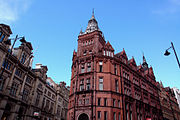- Arnold
- Beeston
- Bingham
- Bulcote
- Burton Joyce
- Calverton
- Carlton
|
- Chilwell
- Cotgrave
- Eastwood
- East Leake
- Edwalton
- Gedling
- Heanor
- Holme Pierrepont
|
- Hucknall
- Ilkeston (Derbyshire)
- Keyworth
- Kimberley
- Kirkby-in-Ashfield
- Langley Mill (Derbyshire)
- Lambley
|
- Lenton
- Long Eaton (Derbyshire)
- Lowdham
- Mansfield
- Netherfield
- Nuthall
- Radcliffe-on-Trent
|
- Radford
- Ripley
- Ruddington
- Sandiacre (Derbyshire)
- Sherwood
- Stapleford
- Sutton-in-Ashfield
|
- Toton
- Trowell
- West Bridgford
|
Architecture

King Street with Alfred Waterhouse's and Watson Fothergill's buildings
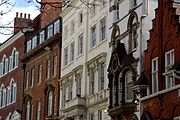
Architecture from different eras side by side
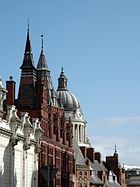
Nottingham Council House and Queen Street
Nottingham is home to a multitude of different architectural styles, with buildings dating from the 1100s. Architects such as Alfred Waterhouse, Thomas Chambers Hine and Nottingham's own Watson Fothergill produced elaborate buildings in the 19th century to meet the expansion generated by increasing industrial output.
The central focal point of the City is Old Market Square which is the largest in the UK and is dominated by the Council House, which replaced The Nottingham Exchange Building, built in 1726. This was built in the 1920s to display civic pride, ostentatiously using baroque columns and placing stone statues of two lions at the front to stand watch over the square. The Exchange Arcade on the ground floor is an upmarket shopping containing high-end boutiques. Portland Stone was used to construct the Council House and Exchange Arcade.
West of the centre
The western third of the city has most of the city's modern office complexes. Tall office buildings line Maid Marian Way. The Georgian area around Oxford and Regent Streets is dominated by small professional firms. The Albert Hall faces the Gothic revival St Barnabas' Cathedral by Pugin. Nottingham Castle and its grounds are located further south in the western third of the city. The central third descends from the University district in the north, past the Gothic revival Arkwright Building – Nottingham Trent University now owns this building as well as many others in the area. Theatre Royal on Theatre Square with its pillared façade was built in 1865. King and Queen Streets are home to striking Victorian buildings designed by the likes of Alfred Waterhouse and Watson Fothergill.
South of the centre
To the south is Broadmarsh Shopping Centre. The Canal-side further south of this is adjacent to the Nottingham railway station and home to numerous redeveloped 19th Century industrial buildings reused as bars and restaurants.
East of the centre
The eastern third of the city centre contains the Victoria Shopping Centre, built in the 1970s on the site of the demolished Victoria Railway Station. All that remains of the old station is the clock tower and the station hotel (now the Nottingham Hilton Hotel). The 250 feet-high Victoria Centre flats stand above the shopping centre and are the tallest buildings in the city. The eastern third contains Hockley Village. ( Photos) Hockley is where the vast majority of Nottingham's unique, independent shops are to be found. It is also home to two alternative cinemas. The Screen Room claims to be the smallest in the world with only 21 seats ( Link), and Broadway Cinema.
Lace Market The Lace Market area just south of Hockley has densely packed streets full of four to seven-story red brick warehouses, ornate iron railings and red phone boxes.
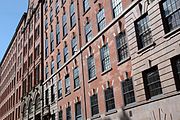
Typical red brick lined street in the Lace Market
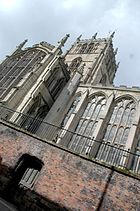
St Mary's church in the Lace Market
New College Nottingham occupies the Adams Building, built by Thomas Chambers Hine for Thomas Adams (1817–1873). Many buildings have been converted into apartments, bars and restaurants. St. Mary's Church, Nottingham on High Pavement is the largest medieval building still standing in Nottingham. The Georgian-built Shire Hall is home to the Galleries of Justice and was Nottingham's main court and prison building for 200 years from 1780, although the site's use as a court stretches back as far as 1375.
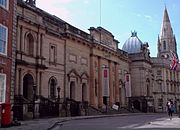
Galleries of Justice in the Lace Market
Pubs
Ye Olde Trip To Jerusalem, partially built into the cave system beneath Nottingham Castle, is a contender for the title of "England's Oldest Pub" due to its supposed establishment in 1189. The Bell Inn on the Old Market Square, and Ye Olde Salutation Inn on Maid Marian Way have both disputed this claim. An episode of the Channel 4 TV documentary series History Hunters tested attributes of the three claimants and found that, while each has its own evidence, none can claim exclusivity. The Trip, whilst the oldest building, was for most of its early life a brewery and not a public house. The Salutation sits on the oldest recognised public house site, but the current building is comparatively recent. The Bell, although not in such an antiquated location, boasts the oldest public house building. There is also conflicting information available: dendrochronology from roof timbers in the Salutation give a date for the building of c.1420 with similar dates for the Bell. Ultimately, the roots of the multiple claims can be traced to various subtleties of definition in terms such as public house and inn.
Education
Secondary education
Nottingham's state schools consistently rank poorly in national league tables. Despite a lot of investment, the closure of numerous schools and the opening of new city academies, Nottingham City LEA remains near the bottom of the league tables at both primary school and secondary school levels. At primary level, Nottingham was ranked fourth from bottom in the country, at 147th out of 150 local authorities rated in 2006, whilst at secondary level, Nottingham came eighth from bottom nationally in terms of GCSE results attained.
Nottingham also has a number of independent schools, with Nottingham High School, which was founded in 1513, being the city's oldest educational establishment by far. Nottingham High School came eighth nationally for A-Levels in 2008 according to the Sunday Times.
Further education
Four further education colleges are located in Nottingham. Castle College is the largest and was formed from the merger of Broxtowe College and the People's College. New College Nottingham is the result of the merger of four smaller further education colleges, whilst Bilborough College is solely a Sixth Form college. South Nottingham College also has a campus in the city centre.

The University of Nottingham, founded in 1798, situated in Highfields Park
Higher education
Nottingham is home to two universities: the University of Nottingham and Nottingham Trent University. Together they are attended by over 40,000 full-time students. The University of Nottingham's teaching hospital, University of Nottingham Medical School, is part of the largest hospital in the UK, the Queen's Medical Centre (aka QMC). The city is home to the headquarters of the National College for School Leadership, whilst the Nottingham School of Fashion is notable for having trained the famous fashion designer Paul Smith.
Economy

Part of the HMRC complex in Nottingham
Nottingham is home to the headquarters of many well-known companies. One of the best known is Boots the Chemists (now Alliance Boots), founded in the city by Jesse Boot, 1st Baron Trent in 1849 and substantially expanded by his son John Boot, 2nd Baron Trent. Other large current employers include the credit reference agency Experian, the energy company E.ON UK, the tobacco company John Player & Sons, betting company Gala Group, amusement and gambling machine manufacturer Bell-Fruit-Games, engineering company Siemens, sportswear manufacturers Speedo, high street opticians Vision Express, games and publishing company Games Workshop (creator of the popular Warhammer series), PC software developer Serif Europe (publisher of PagePlus and other titles), Web hosting provider Heart Internet, the American credit card company Capital One, whose European offices are situated by the side of Nottingham railway station. Nottingham is also the home of HM Revenue and Customs, the Driving Standards Agency, and Nottingham Building Society, set up in 1849.
Although Boots itself is no longer a research-based pharmaceutical company, a combination of former Boots researchers and university spin-off companies have spawned a thriving pharmaceutical/science/biotechnology sector. BioCity, the UK's biggest bioscience innovation and incubation centre, sits in the heart of the city and houses around thirty science-based companies. Other notable companies in the sector include Perceptive Informatics (ClinPhone plc before being bought by Parexel) and Pharmaceutical Profiles. The city was made one of the UK's six Science Cities in 2005 by the then Chancellor Gordon Brown.
Until recently bicycle manufacturing was a major industry, the city being the birthplace of Raleigh Cycles in 1886 and later joined by Sturmey-Archer, the creator of 3-speed hub gears. However, Raleigh's factory on Triumph Road, famous as the location for the filming of Saturday Night and Sunday Morning, was demolished in Summer 2003 to make way for the University of Nottingham's expansion of Jubilee Campus.
Nottingham is also joint headquarters of Paul Smith, the high fashion house.
Creative Industries are a target growth sector for the city with graphic design, interiors and textile design being a particular focus. There is already a thriving design and new media industry in the city.
Nottingham City Council announced that other target sectors include Financial and Business Services, Science and Technology, Public Sector and Retail and Leisure as part of their economic development strategy for the city. The global Business SMS company Esendex was founded in the Lace Market district and now operates in 6 markets across the world. Ceramics manufacturer Mason Cash was founded and continues to have operations in Nottingham.
The schools and aerial photographers, H Tempest Ltd were Nottingham-based for many years, until relocating to St. Ives (Cornwall) around 1960. A skeleton office remained for many years in the original building next to Mundella School.
Many of the UK's railway ticket machines and platform departure boards run software written by Atos Origin in their offices in Nottingham. Other major industries in the city include engineering, textiles, knitwear and electronics. An increasing number of software developers are located in Nottingham: Reuters and Monumental Games are based in the city, with Free Radical Design located in nearby Sandiacre and Serif Europe based between Wilford and Ruddington, south west of the Trent and east of Clifton.
Nottingham is progressively changing from an industrial city to one based largely in the service sector. Tourism — particularly from the United States and the Far East — is becoming an increasingly significant part of the local economy.
In 2004 Nottingham had a GDP per capita of £24,238 (US$48,287, €35,529), which was the highest of any English city after London, and the fourth highest of any city of the UK, after London, Edinburgh and Belfast.
Economic trends
| Year |
Regional Gross
Value Added (£m) |
Agriculture
(£m) |
Industry
(£m) |
Services
(£m) |
| 1995 |
4,149 |
2 |
1,292 |
2,855 |
| 2000 |
5,048 |
1 |
912 |
4,135 |
| 2003 |
5,796 |
– |
967 |
4,828 |
| source: Office for National Statistics |
Shopping
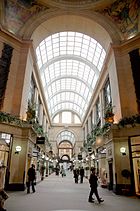
The Exchange Arcade inside the Council House
In 2010, Nottingham was positioned sixth in the retail centre expenditure league of the UK, behind the West End of London, Glasgow, Birmingham, Manchester and Liverpool. This has dropped from fifth in 2007.
There are two main shopping centres in Nottingham: Victoria Centre and Westfield Broadmarsh. The Victoria Centre was established on the site of the former Nottingham Victoria railway station, and was the first to be built in the City, with parking for up to 2,400 cars on several levels and two levels of shopping with bus station. Victoria Centre is also topped by 26 floors of flats, the tallest building in Nottingham. Work on redeveloping Westfield Broadmarsh at a cost of £400 million (creating 400 stores, 136,000 m2 of shopping space) was due to start in 2008. However, the downturn in the economy meant that redevelopment was delayed throughout from 2008 to 2010. Finally in 2010, the centre announced that it would not be redeveloped but instead refurbished. Months after this announcement, the Victoria Centre also announced plan for expansion, to compete with new centres in Derby and Leicester. Smaller shopping centres are The Exchange Arcade, the Flying Horse Walk and new developments in Trinity Square and The Pod. The new developments will increase the shopping sales area in the city centre by 28% to 4,300,000 square feet (400,000 m2). The Bridlesmith Gate area has numerous designer shops, and is the home of the original Paul Smith boutique. There are also various side streets and alleys that hide some interesting and often overlooked buildings and shops – streets such as Poultry Walk, West End Arcade and Hurts Yard. These are home to many specialist shops as is Derby Road, near the Cathedral and once the antiques area but now home to some the city's most interesting independent shops.
Nottingham has a number of department stores including the House of Fraser, John Lewis, and Debenhams. Hockley Village caters to alternative tastes with shops like Ice Nine and Void, famous across the city.
Culture
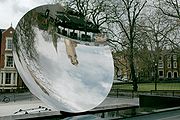
Nottingham Playhouse and Cathedral reflected in Anish Kapoor's Sky Mirror
Theatres
Nottingham has two large-capacity theatres, the Nottingham Playhouse and the Theatre Royal (which together with the neighbouring Nottingham Royal Concert Hall forms the Royal Centre) and a smaller theatre space at the University of Nottingham's Lakeside Arts Centre. The city also has smaller theatres with the Nottingham Arts Theatre and the Lace Market Theatre. Also, within the University of Nottingham Campus grounds, The New Theatre, the only entirely student run theatre in England.
Galleries and museums
There are also several art galleries which often receive national attention, particularly the Nottingham Castle Museum, the University of Nottingham's Djanogly Gallery and Wollaton Park's Yard Gallery. Both of the city's universities also put on a wide range of theatre, music and art events open to the public throughout the year.
- Brewhouse Yard Museum., the museum of Nottingham Life based within five 17th Century cottages at the base of the rock of Nottingham Castle. Once a refuge for persecuted members of dissenting religious groups, today, the museum investigates over 300 years of local history.
- The Galleries of Justice – Museum of Law Trust based at the Shire Hall in the Lace Market
- Green's Windmill and Science Centre – A unique working windmill in the heart of the city that was home to the 19th Century mathematical miller, George Green.
- New Art Exchange. – an award-winning contemporary art gallery based in Hyson Green. Focus on African, African Caribbean and South Asian art.
- Nottingham Castle Museum and Art Gallery – home to the city’s Decorative Art and Fine Art collections, along with the Story of Nottingham galleries, and the Sherwood Foresters Regimental Museum.
- Nottingham Contemporary – Nottingham's newest art centre.
- Nottingham Industrial Museum
- Nottingham Natural History Museum – based at Wollaton Hall.
- Nottingham Transport Heritage Centre in Ruddington is a museum of local transport. It has an eight mile (13 km) long railway where Heritage steam trains and Diesel locomotives are used on passenger runs, a classic Road Transport collection with many Nottingham associated vehicles, a miniature and model railway.
- Nottingham's Independent Arts Centre.
- Lakeside is the University of Nottingham's unique public arts and craft centre.
Cinemas
The city has several multiplex cinemas, the largest being the Cineworld complex sited within The Corner House and Showcase Cinema operated by National Amusements as well as two arthouse cinemas in Hockley. The independent cinemas are the Broadway Cinema, one of the major independent cinemas in the UK and Screen Room, which claims to be the world's smallest cinema (at just 21 seats). Broadway was redeveloped and expanded in 2006. Quentin Tarantino held the British premiere of Reservoir Dogs there in 1992.
Music
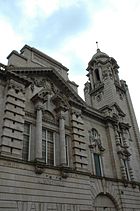
The Albert Hall, Nottingham, an important music venue.
There is a classical music scene, with long-established groups such as the city's Symphony Orchestra, Philharmonic Orchestra, Nottingham Harmonic Society, Bach Choir, Early Music Group Musica Donum Dei and the Symphonic Wind Orchestra giving regular performances in the city.
Nottingham is also well known for Rock City concert venue, along with its sister venues – Rescue Rooms, The Bodega Social Club and Stealth. The city is home to a few independent record labels actively contributing for the alternative rock, pop and garage music scene, such as Hello Thor, Dead by Mono Records. The Sumac Centre based in Forest Fields has for many years supported local upcoming musicians, artists and film makers, and a variety of campaign groups. There are also a large number of live music venues promoting rock and metal music throughout the city, including The Central, The Old Angel, The Maze and Ye Olde Salutation Inn.
Wollaton Park in Nottingham hosts an annual family-friendly music event called Splendour. In 2009 it was held on Sunday 19 July and was headlined by Madness and The Pogues. Splendour returned on 24 July 2010, headlined by The Pet Shop Boys and featuring Calvin Harris, Noisettes, Athlete and OK Go among others.
Nottingham is renowned as one of the biggest cities supporting the Dubstep movement of dance music. Nottingham has several weekly and monthly Dubstep and Drum and Bass nights. It also has a strong 'DIY' music scene, with a large number of independent promoters using a variety of venues, pubs/bars, warehouse spaces and gallerys to host gigs throughout the city.
Food
In the 1980s, Nottingham was barely mentioned in the Good Food Guide; but now there are several restaurant entries and a range of cuisine reflecting the ethnic diversity of the city. The Nottingham Restaurant Awards play a leading role in promoting the industry.
There are several hundred restaurants in Nottingham, with several AA rosette winning restaurants and one Michelin starred restaurant, Sat Bains.
In September of each year, the Old Market Square is host to the Nottingham Food and Drink Festival. This event is organised by We Are Nottingham, a business improvement district funded by the city's bars, restaurants, pubs, and clubs. It features celebrity chefs, market stalls, demonstrations from local chef's, in-venue events in many locations, as well as a free food sampling area.
Tourism

Ferris Wheel in Old Market Square
Nottingham receives around 300,000 overseas visitors each year. Many visitors are attracted by Nottingham's nightlife and shops, by its history, and by the legend of Robin Hood, visiting Sherwood Forest and Nottingham Castle. Popular history-based tourist attractions in central Nottingham include the Castle, City of Caves, Lace Market, The Galleries of Justice, and the City's ancient pubs.
Parks and gardens include Wollaton Park (over 500 acres) near the University Highfields Park on the University of Nottingham campus, Colwick Park, which includes the racecourse, and the Nottingham Arboretum, Forest Recreation Ground and Victoria Park which are in or close to the city centre. Sherwood Forest, Rufford Country Park, Creswell Crags and Clumber Park are further away from the city itself. A new park is being developed in the city at the Eastside City development.
The Nottingham Robin Hood Society was originally formed by Robin Hood historian Jim Lees and two Nottingham teachers Steve and Ewa Theresa West in 1972. Steve and Ewa Theresa played the part of Maid Marion and Robin Hood and attracted a ' band' of like minded followers who ' costumed up ' nearly every weekend for a function. The then society acted in street theatre, appeared at charity events and functions and for several years ' held up ' the appointed Sheriff of Nottingham at the opening of the annual Nottingham Festival. The society also made a film for Japanese Television and joined in picnics and midnight vigils around in Major Oak to promote tourism. Although a Nottingham Robin Hood Society remains, the original society members disbanded after the death of Jim Lees.
There are two main Robin Hood events throughout the Nottingham area, including the Robin Hood Pageant during October, and the Robin Hood Festival during the summer. The pageant is held at the Castle, whilst the festival is held in nearby Sherwood Forest.
In 2009 the Sheriff of Nottingham, Councillor Leon Unczur set up a Commission to look at the possibility of setting up a World Class Robin Hood Attraction. The Commission was due to report in May 2010.
In February 2008, a Ferris wheel was put up in the Old Market Square and was a major attraction of Nottingham City Council's 'Light Night' on February 8. The wheel returned to Nottingham in February 2009 to mark another night of lights, activities, illuminations and entertainment. Initially marketed as the Nottingham Eye, it was later redubbed as the Nottingham Wheel, to avoid any association with the London Eye. It was seen again in 2010, and is now a much welcomed annual event happening in Nottingham.
In 2010, Nottingham has seen a rise in recommendations from publications around the world, including a positive write up in the New York Times as well as being touted as one of the Top 10 Cities to Visit in 2010, alongside Delhi, Nara, Tel Aviv and Reykjavik, by DK Travel.
Entertainment
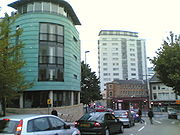
New Buildings on the South Side of the Lace Market area.
The 2,500-capacity Nottingham Royal Concert Hall and 9,500-capacity Nottingham Arena attract the biggest names in popular music. For less mainstream acts and a generally more intimate atmosphere, Nottingham has a selection of smaller venues including Ye Olde Salutation Inn, Seven (formerly Junktion 7), The Old Angel, the award-winning dedicated rock music venue Rock City and the smaller sister venues The Rescue Rooms, The Bodega Social Club and Stealth. These venues, with their close proximity, make Nottingham one of the centres of live popular music in the UK.
The large number of students in the city bolsters the night time entertainment scene. There are several well established areas of the city centre for entertainment such as Lace Market, Hockley, The Waterfront and The Corner House.
Sport
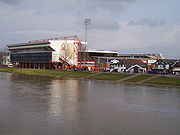
The City Ground and River Trent
Nottingham is home to two high profile football clubs – former double European Cup winners Nottingham Forest F.C. and Notts County F.C, the latter of which is the world’s oldest fully professional football club. Championship Nottingham Forest’s home stadium is The City Ground, with a capacity of just over 30,000, which was one of the stadia for Euro 96. League One Notts County is based at the 20,000-seat Meadow Lane stadium on the opposite side of the River Trent. The two grounds are notable for being the closest in English league football.
Ice hockey
Ice Hockey is one of the biggest and most popular sports in Nottingham. The city is home to the biggest ice hockey team in Britain the Nottingham Panthers who regularly sell out their home arena which is the 7,500 capacity National Ice Centre. The team compete in the 10 team professional Elite Ice Hockey League. Within the league are the Sheffield Steelers who hold an intense rivalry with the Nottingham Panthers The NIC currently hosts the Playoff Finals weekend for the Elite League. Over 2 days, the semi finals and finals are played.
National Watersports Centre
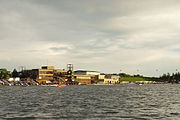
Holme Pierrepont National Watersports Centre
The National Water Sports Centre is based at Holme Pierrepont, with a 2000 metre regatta lake for rowing, canoeing and sailing, and a white water slalom canoe course fed from the river.
Cricket
Nottingham is also home to the 2010 Cricket County Champions Nottinghamshire County Cricket Club, who play at Trent Bridge (a major international cricket venue with a capacity of 17,000) and a regular host of Test Cricket each summer. In 2009 the city was chosen as one of the three host cities for the ICC T20 tournament.
Rugby Union
Nottingham is also home to Championship Nottingham RFC who play their home games at League One Notts County's Meadow Lane stadium
Mixed Martial Arts
Being the birthplace of Dan Hardy & Paul Daley, and one of the locations of Team Rough House (the other being Leicester), Nottingham has gained a reputation as being one of the hotbeds of British Mixed Martial Arts, drawing fighters such as Ross Pearson, Andre Winner, Nick Osipczak & Dean Amasinger.
Other sports
Notable sporting events that take place in the city include the annual tennis AEGON Trophy which is staged at the City of Nottingham Tennis Centre and the Robin Hood Marathon.
Transport
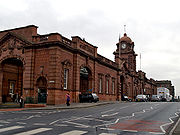
Nottingham railway station
Nottingham is served by East Midlands Airport at Castle Donington which is within 20 miles of Nottingham and is the 10th busiest airport in the UK in terms of passenger traffic. It is connected to the city by the Skylink bus service. Nottingham is also well connected by both road and rail. The M1 motorway is close by and rail services to other major cities which are all operated by East Midlands Trains with the exception of the Nottingham to Cardiff service run by CrossCountry and the Nottingham to Leeds service run by Northern Rail. The Robin Hood Line links the city with Mansfield and other towns in the north of the county.
The opening of Nottingham Express Transit in 2004 made Nottingham one of only six English cities to have a light rail system. The trams run from the city centre to Hucknall in the north, with an additional spur to the Phoenix Park Park and Ride close to Junction 26 of the M1. Two new lines are in the planning process to the southern suburbs of Wilford and Clifton and the western suburbs of Beeston and Chilwell.
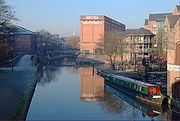
British Waterways building (formerly the Trent Navigation Company warehouse) on the Nottingham Canal
The vast majority of Nottingham’s local bus services are operated by Nottingham City Transport which runs a colour-coded network of 68 routes and is the city’s fifth largest private employer. Trent Barton is the other major bus operator, running services from Nottingham to locations throughout the East Midlands. Both companies are frequent winners at the National Bus Operator of the Year awards.
Nottingham’s waterways have been extensively used for transport in the past, with the River Trent, up until the mid 20th century, providing important industry transport links, along with both the Nottingham and Beeston Canals. These are now primarily used for leisure.
In September 2010 research by the Campaign for Better Transport rated Nottingham as the least car dependent city in England with London and Brighton & Hove in second and third place respectively.
In November 2010, Nottingham City Council won Transport Authority of the Year by the UK Bus Awards, for services for providing safer and sustainable public transport. Nottingham City Council has 2 hybrid Alexander Dennis Enviro400Hs on order which are due for delivery early next year, it is not known if they will be handed over to their owned transport operator Nottingham City Transport.
Crime
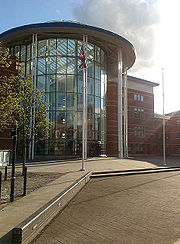
Nottingham Magistrates' Court
Nottingham is served by Nottinghamshire Police and has a Crown Court and Magistrates' Court.
Between 2000 and 2003 the press and other media claimed Nottingham was the 'gun-crime capital of the UK', and was dubbed "Shottingham" in some areas. In 2005, it had one of the highest crime rates in the country, with 115.5 crimes per 1000 people. By 2007 the BBC reported that the number of shootings in the city had fallen from 51 (in 2003) to 13 (in 2006). However, in January 2008 it was reported that gun crime in the city had risen for a second consecutive year, with a 50% increase in gun crime during 2007. The incidence rate of many crimes in Nottingham is several times higher than the English average. A crime survey by Reform stated that Nottingham topped the crime rankings for police statistics on murders, burglaries, and vehicle crime, and "had almost five times the level of crime as the safest town in the rankings". The survey was condemned as inaccurate by Nottingham City Council and Nottinghamshire Police due largely to the use of out of date (2001) population figures. The University of Nottingham argued that the way in which statistics such as these are calculated is severely flawed; if the population of the entire conurbation were taken into account instead of just the centre of the city then a more accurate picture would be revealed. A revised survey based on 2004 population estimates, however, appeared to back up the original rankings. In 2007 TV programme Location, Location, Location named Nottingham as the 4th worst city to live in, stating the city has "loads of good aspects but crime lets it down". The programme also ranked the neighbouring Nottinghamshire borough of Rushcliffe, which contains suburbs of greater Nottingham, among the best 20 places to live in the UK.
Violent crime is a problem in Nottingham with knife crime a continual concern. Tourists having been fatally injured.
While the crime figures in the city are high, initiatives introduced to tackle the levels of crime appear to be having an effect, with a 2006 Home Office survey showing that the overall level of crime in the city was down by 12% since 2003. Initiatives include the Community and Neighbourhood Protection Service developed by Nottingham City Council, Nottinghamshire Police and Nottingham City Homes to take an uncompromising stance towards anti-social behaviour. It comprises Community Protection Officers (CPOs), Police Officers, Police Community Support Officers (PCSOs) and Anti-Social Behaviour Officers who work with internal and external agencies to reduce anti-social behaviour and the fear of crime.
Community Protection Officers (also known as City Wardens) in their high-visibility stab vests, are accredited by the Chief Constable of Nottinghamshire Police to issue Fixed Penalty Notices (FPNs) for littering and are employed to tackle other anti-social behaviour.
Like most industrialised cities and large towns, Nottingham attracted a significant influx of Commonwealth immigrants after the Second World War. These immigrants, from Ireland, Asia and the Caribbean, were greeted with hostility from a large percentage of the city's residents, and in the summer of 1958 Nottingham was the scene of some of Britain's very first race riots.
More recently, racial tension in Nottingham has been a major factor in a number of serious crimes. In July 2005, shortly after the London terrorist attacks in which 52 people were killed by Muslim suicide bombers, 48-year-old Pakistan born Muslim man Kamal Raza Butt was beaten to death in the Meadows area of the city. 17-year-old white British teenager Nathan Williams was accused of his murder in May 2006 but cleared on the charge after witnesses refused to testify in court. Nathan Williams was fatally stabbed in the Meadows area just four months later.
Religion
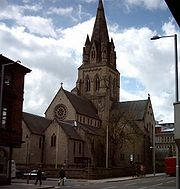
The Roman Catholic Cathedral of St. Barnabas from Derby Road
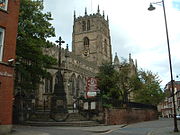
St. Mary the Virgin also known as St. Mary's in the Lace Market
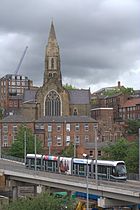
Unitarian Chapel on High Pavement, now the Pitcher and Piano public house
Nottingham has three notable historic Anglican parish churches all of which date back to mediæval times. St. Mary the Virgin, in the Lace Market, a member of the Greater Churches Group is the oldest foundation (dating from the eighth or ninth centuries) but the building is at least the third on the site dating from 1377 to 1485. St. Mary's is considered the mother church of the city and civic services are held here, including the welcome to the new Lord Mayor of Nottingham each year. St.Peter's in the heart of the city is the oldest building in continuous use in Nottingham, with traces of building starting in 1180. St. Nicholas' was rebuilt after destruction in the Civil War.
Non-conformism was strong from the 17th century onwards and a variety of chapels and meeting rooms proliferated throughout the town. Many of these grand buildings have been demolished, including Halifax Place Chapel, but some have been re-used, notably High Pavement Chapel which is now a public house. The offices of the Congregational Federation are in Nottingham. William Booth, the founder of the Salvation Army, was born in Nottingham in 1829.
The Roman Catholic Cathedral of St. Barnabas on Derby Road was designed by the architect Augustus Welby Northmore Pugin, it was consecrated in 1844 and is the cathedral church for the Roman Catholic Diocese of Nottingham established in 1850 which covers Nottinghamshire (except Bassetlaw District), Leicestershire, Derbyshire (except Chesterfield and parts of the High Peak), Rutland and Lincolnshire (pre-1974 boundaries).
Today there are places of worship for all major religions, including Christianity, Islam, Hinduism, Sikhism, Taoism and Judaism. The Nottingham Inter-faith Council works to make connections between faith groups and show the wider public the importance of spiritual aspects of life and the contribution faith groups make to the community.
Twin cities
Nottingham is twinned with the following cities:
Notable people
List of Mayors and Lord Mayors
The Sheriff of Nottingham
|









